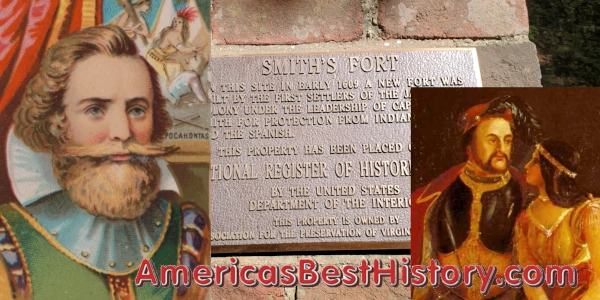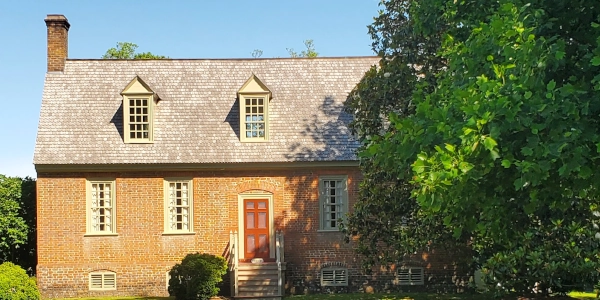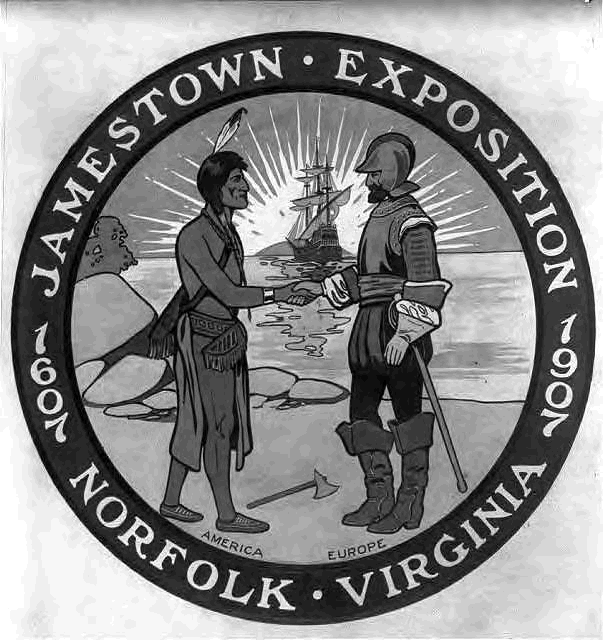Sponsor this page. Your banner or text ad can fill the space above.
Click here to Sponsor the page and how to reserve your ad.
-
Timeline
1609 Detail
June 15, 1609 - John Smith discontinues building a retreat fort across from Jamestown due to the advent of the Starving Time for two years at the Jamestown Settlement. Acreage around Smith's New Fort would become the dowry by her father to Pocahontas after her marriage to John Rolfe.

Since their landing at Jamestown Settlement in 1607, life had been harsh at the fort on the north side of the James River. There had been disease, attacks by the Powhatan Confederacy, and other complications for the settlers and their council. Captain John Smith, previously captive on their journey to the America's, was on that council, and thought, by the middle of 1608, that a fort for retreat, if necessary, should be built on a bluff across the James River on its south side. It would be built at a position that would be difficult to attack by water, as English cannon could spot and bombard invaders, whether native or Spanish. The steep bluff would be an arduous climb for an enemy facing the teeth of what would be known as "Smith's New Fort." Work began on the fort in late 1608 or early 1609. It would be about the same size as the Jamestown fort, perhaps a bit over an acre inside. His men began to dig the entrenchments and build the earthen walls. However, by mid-June of 1609, it was relayed to him at the site that disaster had struck the main settlement. Rats had infested much of their corn supply, greatly diminishing their attempt to store enough by winter in order to survive. This was a more important issue. John Smith abandoned the New Fort, never to be completed in the future. The date, June 15, is an estimate, although the month is thought to be June. However, remnants of that fort still stands today, much to do with the efforts of Preservation Virginia, which runs Smith's Fort Plantation as a history attraction.
For the settlers at Jamestown after Captain John Smith discontinued building the fort, was that it signalled the beginning of the Starving Time, two years of loss of supplies and settlers.
The Starving Time
The Virgina Company knew something had to be done and sent a flotilla of nine ships with more colonists and supplies so they could make it through the winter. But the ships were hit by a hurricane with the largest, the Sea Venture, with venture stalwarts Christoper Newport, Sir George Somers, and Sir Thomas Gates among them. Finally in August, the remnants of the other ships reached Jamestowne with three hundred people but few supplies. Captain John Smith attempted to trade with the native population, but between his previous strong armed tactics and a seven year drought for both the Native population and the colonists, there was little to recieve.
After Captain Smith returned to England in October due to an injury from a gunpowder explosion, George Percy was put in charge. With dwindling food supplies, forcing settlers to leave the safety of Fort James, the edict from Chief Powhatan to kill the colonists who left the fort caused many casualties. The colonists ate their horses, dogs, and mice, with some reports that they ate each other. By the time the Sea Venture arrived on May 24, 1610, there were only sixty colonists left at the fort. Two of every three people had died over those two years. James Fort was set to be abandoned, even though Powhatan's siege had been called off to resume their spring plantings, with the remaining settlers sailing back to England. Before that, a new Governor arrived, Lord de la Warr, who insisted they rebuild.
The Dowry of Pocahontas
John Rolfe was a planter on a significant plantation thirty miles up the James River who had befriended Pocahontas, now known as Rebecca, during her capture by the English. On April 5, 1614, with the blessings of the father, Wahunsenaca, the Powhatan chief, a marriage ceremony was held tying the knot between John Rolfe and Rebecca. As was the custom at the time, Powhatan was obliged to give a dowry, and although a dowry between the Native Americans to an Englishman would be the first, he was very generous with his donation. Pocahontas, i.e. Rebecca's, dowry with the acreage, eight hundred to one thousand, that spread from and included John Smith's New Fort between two creeks.
The land was good and John Rolfe began to plant his tobacco crop there in 1614. He was the first person to cultivate tobacco for commercial purposes. He built a house for them, and eventually their son Thomas, born 1615. For centuries it was thought the Rolfe house was the house you will see in the video below, but in recent years, dating of the wood in the house proved that it was not. This was a disappointment, even to the man John Rockefeller, Jr., who had bought the plantation in 1928 for the Williamsburg Holding Company. It was sold to Preservation Virginia to refurbish, maintain, and interpret in 1933. The date of the house certainly retains its historic value as a 1765 plantation manor home built before the American Revolution. With a central hall, a meeting parlor, and couple's bedroom on the first floor, and two bedrooms on the second, one for the male children and the other for the female, the manor home is an elegant example of the architecture of the time. The Rolfe's would only live there for two years before they made their historic trip to England in 1616 to promote the colony of Virginia to future settlers, where they, or more accurately Pocahontas, were treated as royalty. Pocahontas would become ill and die there. John Rolfe would return to Virginia, leaving son Thomas and daughter Elizabeth under the care of a family member in England. Thomas would return, likely in 1635, work the lands inherited after his father's death and become a lieutenant in 1646 to protect English forts from the Native population.
Minute Walk in History
John Smith's New Fort and Pocahontas Dowry
This historic site is a wonderful amalgamation of stories that start, in European terms, with the building of an escape fort above a bluff of the James River, when Captain John Smith thought the original fort was too vulnerable to Powhatan Confederacy and Spanish attack. Unfortunately, the fort was not completed, 1609, after Smith found out that the food stock, corn, at Jamestown had been destroyed by rats. This led to two years of the Starving Time, and many settler deaths.
Several years later, the site of Smith's fort would become Powhatan's dowry for his daughter, Pocahontas, and her wedding to Englishman John Rolfe. Eight hundred acres on which they would build a house. The house you will see was thought to be that house for hundreds of years, but now is known as the 1765 house, with the probability of the Rolfe-Pocahontas foundation beneath it. That house would go through many owners, even John D. Rockefeller, who helped preserve the property for five years before selling to Preservation Virginia. Awesome site to visit.

Life for the Plantation After Pocahontas and Rolfe Left for England
Son Thomas Rolfe owned the plantation of his mother's dowry until 1650, at some time co-owning in with Thomas Warren. In 1751/1765, the plantation was bought by Jacob Falcoun, who built the house that remains on the property today. It was owned by Stith and Maime Spratley prior to 1886.
My favorite story of the day was the recounting by the guide of what happened after the Civil War. Four formerly enslaved families, sharecroppers, bought the plantation, then known as Gray's Creek Farm with five hundred and twenty-one acres, for $2,500 in 1886; Carter and John Hardy, Robertson Simmons, and Bolling Morris. They worked and lived in the 1765 house, with addition now gone, for decades. It is remarkable that they could have raised that amount of money after such degradation, and it is a testament to their families that should be remembered forever. The Morris family sold it to John D. Rockefeller, Jr., for the Williamsburg Holding Company, for $9000 in 1928.
Today, Smith's Fort or Smith's Fort Plantation, is still run as a historic site by Preservation Virginia, bought by them in 1933. There is a half-mile self guided trail to the site of Smith's New Fort, uniquely through a cow field. Yes, cows might come to greet you. There is a cell phone tour of the grounds, and don't miss the fabulous tour of the home, including a complete history of Jamestown, Captain John Smith's New Fort, the house, both past and present and the decades in between. Yes, from John Rolfe, Pocahontas, Jacob Falcoun, plus the Morris, Hardy, and Simmons Families. Yes, and John Rockefeller steps in there as well. The historic site is located at 217 Smith Fort Lane, Surry, Virginia 23883. Website - Smith's Fort Plantation. The site is open Thursday through Sunday. House tours are conducted from March to December.
Source: Image above: Montage of images (left) Print of John Smith, 1888, W. Duke Sons and Co. Courtesy Library of Congress; (center) Stone tablet at site of the remnants of Smith's Fort, 2025. Courtesy America's Best History; (right) John Rolfe and Pocahontas, 1850, J.W. Glass. Courtesy Wikipedia Commons. Image below: The Smith's Fort Plantation House, 2025. Courtesy America's Best History. Info source: Preservation Virginia, Smith's Fort Plantation, "Smith's Fort, an American Story," Jennifer Hurst Wender, Preservation Virginia Blog; National Trust for Historic Preservation, historicjamestowne.org; encyclopediavirginia; National Park Service; Wikipedia.

History Photo Bomb

For the settlers at Jamestown after Captain John Smith discontinued building the fort, was that it signalled the beginning of the Starving Time, two years of loss of supplies and settlers.
After Captain Smith returned to England in October due to an injury from a gunpowder explosion, George Percy was put in charge. With dwindling food supplies, forcing settlers to leave the safety of Fort James, the edict from Chief Powhatan to kill the colonists who left the fort caused many casualties. The colonists ate their horses, dogs, and mice, with some reports that they ate each other. By the time the Sea Venture arrived on May 24, 1610, there were only sixty colonists left at the fort. Two of every three people had died over those two years. James Fort was set to be abandoned, even though Powhatan's siege had been called off to resume their spring plantings, with the remaining settlers sailing back to England. Before that, a new Governor arrived, Lord de la Warr, who insisted they rebuild.
The land was good and John Rolfe began to plant his tobacco crop there in 1614. He was the first person to cultivate tobacco for commercial purposes. He built a house for them, and eventually their son Thomas, born 1615. For centuries it was thought the Rolfe house was the house you will see in the video below, but in recent years, dating of the wood in the house proved that it was not. This was a disappointment, even to the man John Rockefeller, Jr., who had bought the plantation in 1928 for the Williamsburg Holding Company. It was sold to Preservation Virginia to refurbish, maintain, and interpret in 1933. The date of the house certainly retains its historic value as a 1765 plantation manor home built before the American Revolution. With a central hall, a meeting parlor, and couple's bedroom on the first floor, and two bedrooms on the second, one for the male children and the other for the female, the manor home is an elegant example of the architecture of the time. The Rolfe's would only live there for two years before they made their historic trip to England in 1616 to promote the colony of Virginia to future settlers, where they, or more accurately Pocahontas, were treated as royalty. Pocahontas would become ill and die there. John Rolfe would return to Virginia, leaving son Thomas and daughter Elizabeth under the care of a family member in England. Thomas would return, likely in 1635, work the lands inherited after his father's death and become a lieutenant in 1646 to protect English forts from the Native population.
John Smith's New Fort and Pocahontas Dowry
Several years later, the site of Smith's fort would become Powhatan's dowry for his daughter, Pocahontas, and her wedding to Englishman John Rolfe. Eight hundred acres on which they would build a house. The house you will see was thought to be that house for hundreds of years, but now is known as the 1765 house, with the probability of the Rolfe-Pocahontas foundation beneath it. That house would go through many owners, even John D. Rockefeller, who helped preserve the property for five years before selling to Preservation Virginia. Awesome site to visit.

My favorite story of the day was the recounting by the guide of what happened after the Civil War. Four formerly enslaved families, sharecroppers, bought the plantation, then known as Gray's Creek Farm with five hundred and twenty-one acres, for $2,500 in 1886; Carter and John Hardy, Robertson Simmons, and Bolling Morris. They worked and lived in the 1765 house, with addition now gone, for decades. It is remarkable that they could have raised that amount of money after such degradation, and it is a testament to their families that should be remembered forever. The Morris family sold it to John D. Rockefeller, Jr., for the Williamsburg Holding Company, for $9000 in 1928.
Today, Smith's Fort or Smith's Fort Plantation, is still run as a historic site by Preservation Virginia, bought by them in 1933. There is a half-mile self guided trail to the site of Smith's New Fort, uniquely through a cow field. Yes, cows might come to greet you. There is a cell phone tour of the grounds, and don't miss the fabulous tour of the home, including a complete history of Jamestown, Captain John Smith's New Fort, the house, both past and present and the decades in between. Yes, from John Rolfe, Pocahontas, Jacob Falcoun, plus the Morris, Hardy, and Simmons Families. Yes, and John Rockefeller steps in there as well. The historic site is located at 217 Smith Fort Lane, Surry, Virginia 23883. Website - Smith's Fort Plantation. The site is open Thursday through Sunday. House tours are conducted from March to December.
Source: Image above: Montage of images (left) Print of John Smith, 1888, W. Duke Sons and Co. Courtesy Library of Congress; (center) Stone tablet at site of the remnants of Smith's Fort, 2025. Courtesy America's Best History; (right) John Rolfe and Pocahontas, 1850, J.W. Glass. Courtesy Wikipedia Commons. Image below: The Smith's Fort Plantation House, 2025. Courtesy America's Best History. Info source: Preservation Virginia, Smith's Fort Plantation, "Smith's Fort, an American Story," Jennifer Hurst Wender, Preservation Virginia Blog; National Trust for Historic Preservation, historicjamestowne.org; encyclopediavirginia; National Park Service; Wikipedia.






